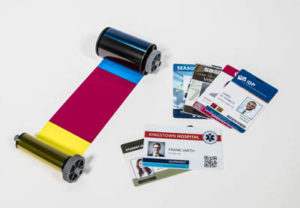Plastic Card Printing |
 |
| Plastic cards are prevalent in our daily lives, such as payment cards, driver’s licenses, membership cards and employee identification badges. Their standard size, portability and durability makes them the ideal choice for many applications. Card printers let you print customised, secure and cost-effective cards on demand. Cards can be printed in colour or monochrome and can be encoded with multiple features like magnetic stripes or RFID to extend their use from highly secure employee IDs to gift card applications. To print images onto plastic cards, card printer uses dye sublimation technology. The dye sublimation process uses three panels (YMC) for colour and one panel (K) for black. YMC are used for colour picture and K for black text. An overlay panel is used to protect colour picture and text from wear and tear. |
|
|
| For Further Reading SMART ID Card Printer has one of the latest technology in card printing. PVC cards (Plastic Cards) need more than just traditional printers, due to their polished nature. SMART ID Card Printer uses a process called Thermal Transfer, to cater specifically to these type of cards. This process of Thermal Transfer is self-explanatory. A coloured ribbon from the printer is placed on the sleek surface of the card, and a thermal print head will heat up the ribbon. This layer of colour will evaporate due to the high heat, but instantaneously turns back to its solid state once it reaches the surface of the card. Thus, an image or colour is formed on the card. It is a standard performance for card printing to be 300 dpi (300 dots per inch, equivalent to 11.8 dots per mm). SMART™ID Card Printer offers an array of printing ribbons, to make sure that a design for a card is only limited by imagination, not by the number of colours. Besides the usual monochrome ribbons, various colour ribbons are also available, each with their own unique printing options. Some featured SMART™ID Card Printer’s ribbons includes BYMCKO Ribbon, a full-colour printing ribbon capable of producing high quality graphics, and also includes an overlay panel on the cards, protecting it further from wear and tear. Another interesting feature is the YMCKFO Ribbon, which is capable of printing ultraviolet (UV) graphics, to be used as a security feature by companies. — The basic principle of a card printer is that a plastic card (normally PVC) is passed through a thermal printer head and a colour ribbon simultaneously. Through heat given out by the printer head, the colour from the ribon is transferred onto the card. SMART uses 2 different printing process: Thermal transfer and Dye sublimation Thermal Transfer Dye Sublimation |




